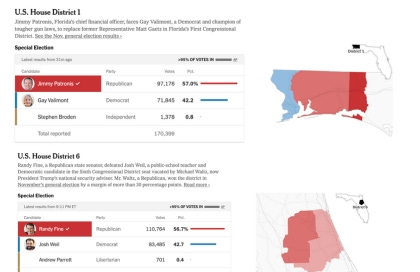Yesterday, Florida held elections for two key seats with significant implications for control of the U.S. House of Representatives. While many across the country saw ads and read stories about how close these races were, it's essential to focus on the hard numbers rather than rely on anecdotal evidence.
After former Rep. Matt Gaetz withdrew from consideration for President Trump’s Attorney General position, he was left without a congressional seat, having already vacated it. This left District 1 open for a special election. Similarly, in District 6, former Rep. Michael Waltz resigned to become the U.S. National Security Advisor, creating another vacancy and triggering a special election.
Both elections ended in decisive Republican victories, with margins exceeding 10 percentage points. This result was unsurprising given that President Trump won both districts by over 30 points in the 2024 election. If anything, the fact that these races were relatively competitive speaks to the strength of the Democratic campaigns and dissatisfaction with some of Trump’s recent actions. Historically, special elections can offer hope to the minority party due to lower turnout among the majority party’s voters. A prime example is Florida State House District 35, where in January 2024, Tom Keen flipped a historically red seat blue for the first time in over 40 years—though he ultimately lost his re-election bid that November. However, special elections typically only provide an opportunity to flip seats that are already competitive, where lower turnout can work to the challenger's advantage. Given Florida’s political landscape, Democrats’ losses yesterday were entirely predictable.
Leading up to April 1, multiple reports highlighted the substantial fundraising efforts for these races. Democrats raised over $16 million combined in an effort to send a strong message that Floridians were unhappy with President Trump’s leadership. However, once pre-election FEC reports were released, questions arose about how these campaigns spent their funds. For instance, Josh Weil’s District 6 campaign reportedly spent over $60,000 on an Airbnb featuring a pool, gym, and tennis court, intended as both a campaign office and a temporary residence for the candidate. Additional questionable expenditures included flights, car repairs, and thousands of dollars in “candidate salary” payments to Weil himself.
Another controversial expense involved the digital fundraising firm hired for these races. Key Lime Strategies & Media collectively received over $4.5 million in wages from both campaigns. Regardless of the services provided, it's hard to justify a consultant making over $1 million in just four months—more than 20% of each campaign’s total haul.
There were many flaws in these campaigns, but a key issue was the messaging. No matter how many direct-to-camera ads claimed these races were "neck and neck," that did not change the voter registration advantage or the results of the November election just five months prior. Democratic donors across Florida and the nation are eager to push back against Trump’s agenda, but pouring money into these races did not achieve that goal. In fact, high-profile endorsements from figures like Sen. Bernie Sanders or the DNC’s involvement only increased the visibility of the races, prompting Trump to respond with virtual rallies and vocal endorsements of both Republican candidates.
So, what’s the problem with raising so much money?
The issue is that it reinforces the worst stereotypes about the Democratic Party—that it serves as a vehicle to funnel money from working-class donors into the pockets of consultants. As a Democratic consultant myself, I firmly believe in the value of campaign professionals, but when consultants deliberately inflate fundraising numbers to boost their own salaries, that presents a serious conflict of interest—if not an outright ethical and legal violation. At a time when the Democratic Party is undergoing significant soul-searching, the last thing we need is bad actors reinforcing the notion that we prioritize personal profit over fighting for working people.
Another major concern is donor fatigue. Most of the funds for these races came from grassroots supporters. Unlike billionaires like Elon Musk, ordinary Americans have a limited amount they can contribute. When candidates misrepresent the competitiveness of a race and then spend large sums on consultants—or themselves—it discourages future donations. No one will be eager to give again after learning how their money was used.
Just south of District 6, in counties like Orange, there are winnable races for Democrats. Central Florida remains one of the state’s only true blue strongholds. As we approach municipal elections in 2025 and the start of the 2026 campaign cycle, we may find that resources are lacking for races that could have made a real difference. If donors and voters lose faith in our party’s infrastructure, it will only lead to more losses—for the party and, ultimately, for working families.




Excellent write up and read on the spending and need for good people as we rebuild!